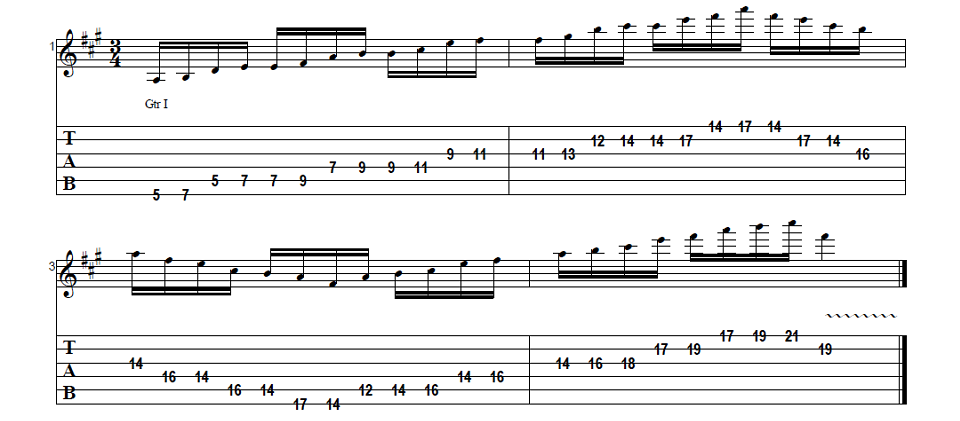Learn to play a fun and easy extended pentatonic sequence in F#m with Guitar Control instructor Darrin Goodman, aka Uncle D. Be sure to get the free tabs to go along with the step by step video instruction and you will be rockin’ this pentatonic sequence in record time.

Introduction
How’s it going everybody? This is Darrin with GuitarControl.com bringing this video lesson and today I’ve got a lead guitar lesson for you and this is kind of for the beginners. This is a sequence that is movable you can do it in different keys and play it in different places on the neck; but it’s just these little shapes that really helps to be able to piece it together and then it also uses the tried and true pentatonic scale.
So right now, Guitar Control is giving away this really awesome daily practice routine to improve your lead guitar chops. This was put together by our very own Silvio Gazquez, a two-time Guitar Idle finalist. This routine covers the four main concepts that are necessary for lead guitar; alternate picking, legato, sweep picking and tapping. All the tabs and exercises are all included in this free ebook and there’s a link in the description where you can get yours.
So be sure to click on the link in the description for the tabs and let’s get close up and take a look at this.
Extended Pentatonic Sequence In F#m
All right, so we’re starting right here on the fifth fret of the low E string and we’re starting on an A, but this is actually an F sharp minor. So if we were going to play F sharp minor the pentatonic box we would start here on the second fret and our second note would be A. So if you just remember that that this sequence if you just put whatever pentatonic key you choose if you just start this on the second note of the scale, you know so the second note on the low E string and then play the sequence. So we’re going to start here on the fifth fret and we’re going to go five, seven and then we’re going to go to the A string and go five, seven. Now we’re just going to shift up a whole step starting on the A string, seven, nine and then go to seven, nine on the D string… Now we’re going to move that up a whole step now we’re going to go 9, 11 and then 9, 11 on the G string… Now we’re going to shift up a whole step and we’re going to go 11, 13 on the G string and now when since the B string is tuned a half step lower than the other strings we have to shift up a half step; so we’re going to go 12, 14 and then we’re going to shift up a whole step 14, 17. Now the reason for why we’re going up a half step now instead of just being a whole step in between is because we’re inside of the box now for the F sharp minor pentatonic pattern. So let me go to the high E string, it’s gonna be the same thing, 14, 17. Now we just descend minor pentatonic number one… now this is where it’s going to end, but rather than use my first finger I’m going to bring my third finger down because what we’re going to do now is we’re going to ascend another pentatonic sequence that I’ve taught in previous lesson. It was just kind of a way that to play the pentatonic boxe positions, but more horizontally across the fretboard; I’ll leave a link down in the description for that. Okay so we descend and now we’re starting here on the 14th fret of the low E string and now we’re gonna go to the 12th fret of the A string, 14th fret and then to the 16th fret. So it’s all whole steps, whole step down and then up. Now we’re going to go to the D string 14, 16 and then to the G string 14, 16. Now shift up a whole step and we’re going to go to the B string and we have to do that same compensation for the string being lower. So we’re going to start here on 17 to 19 to the high E string 17, 19, 21 and then 19 there on your B string… So the whole thing… So with that we’ve covered a really big part of the fretboard in just one key and again this can be moved around. So all you do is follow the same sequence from wherever you start. Just remember that the first note of this is the second note of the first pattern of pentatonic. So if I wanted to do it in A, minor pentatonic starts here, so this would be our first note and then just follow the same sequence that we did before.
Conclusion
All right, so there you have it, not too terribly difficult extended pentatonic sequence. So if you like this pentatonic sequence lesson be sure to give me a thumbs up and leave a comment down below if you have any questions about this or other guitar related topics. If you haven’t already done so please subscribe to the channel and hit that notification bell so you don’t miss any of the content that we upload throughout the week. Well that is all I have for you today. Thanks for watching extended pentatonic sequence in F#m and have a great day.



